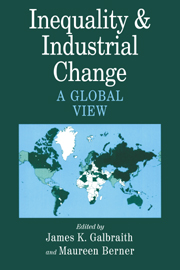Book contents
- Frontmatter
- Contents
- Contributors
- Permissions
- Acknowledgments
- PART I INTRODUCTION TO THEORY AND METHOD
- 1 The Macroeconomics of Income Distribution
- 2 Measuring Inequality and Industrial Change
- PART II INEQUALITY, UNEMPLOYMENT, AND INDUSTRIAL CHANGE
- PART III INEQUALITY AND DEVELOPMENT
- PART IV METHODS AND TECHNIQUES
- Data Appendix
- References and Selected Bibliography
- Index
1 - The Macroeconomics of Income Distribution
Published online by Cambridge University Press: 05 June 2012
- Frontmatter
- Contents
- Contributors
- Permissions
- Acknowledgments
- PART I INTRODUCTION TO THEORY AND METHOD
- 1 The Macroeconomics of Income Distribution
- 2 Measuring Inequality and Industrial Change
- PART II INEQUALITY, UNEMPLOYMENT, AND INDUSTRIAL CHANGE
- PART III INEQUALITY AND DEVELOPMENT
- PART IV METHODS AND TECHNIQUES
- Data Appendix
- References and Selected Bibliography
- Index
Summary
Inequality has become perhaps the foremost preoccupation of modern empirical economics. Yet the conventional theoretical explanations of changing inequality rest on premises long ago demolished on logical grounds. This chapter summarizes a Keynesian theory of income distribution. The theory integrates macroeconomic and distributive phenomena and so accounts for the empirical relationship between the changing shape of the distribution and major macroeconomic events.
Introduction
Income inequality is surely “the prevailing social issue of our time.” But the development is recent. The rise in income inequality in postwar America dates only to 1970 and the reemergence of inequality as a social issue only to the late 1980s. It took the spur of Reaganism, with its celebration of conspicuous differentiation, to reawaken class consciousness in American political life. Before that time, attention had been on other issues for nearly sixty years.
The original submergence of class was a liberal achievement. It was perhaps John Maynard Keynes's greatest service to capitalism that he focused attention on jobs, that unemployment and not equality was the great issue of the Great Depression. In the Keynesian period – from 1945 to 1970 – income inequalities received scant scholarly attention. The great leveling achieved during World War II seemed to have become a fact of nature, and attention shifted to poverty as the organizing principle for social action. As early as 1957, John Kenneth Galbraith observed that “few things are more evident in modern social history than the decline of interest in inequality as an economic issue.”
- Type
- Chapter
- Information
- Inequality and Industrial ChangeA Global View, pp. 3 - 15Publisher: Cambridge University PressPrint publication year: 2001
- 4
- Cited by



